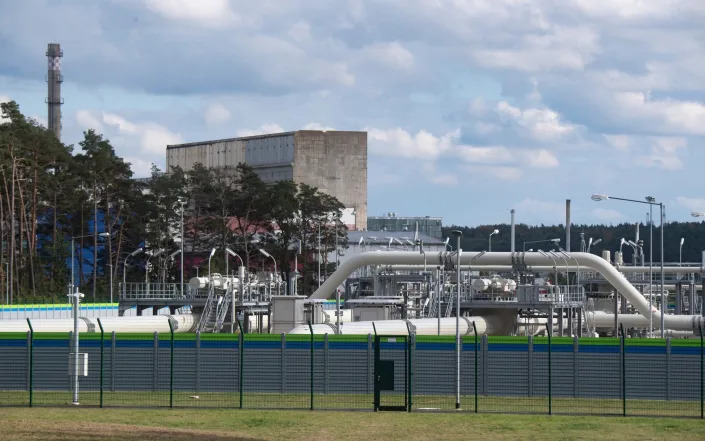Getting an abortion in Italy can be difficult. Is it about to get much tougher?
“We can’t go back to the Middle Ages.”
By Andrea Carlo • Updated: 29/09/2022 -
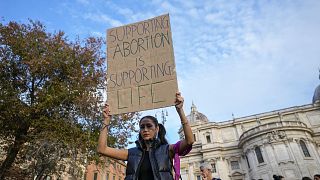
People stage a protest on 'International Safe Abortion Day' in Rome. Wednesday, 28 September 2022. - Copyright
In the middle of a leafy Roman suburb, a tattered billboard glows under the scorching summer heat.
“I am against abortion,” it reads, accompanied by a black-and-white picture of the late film director, Pier Paolo Pasolini.
The use of Pasolini — an avowedly progressive, gay man — in an anti-abortion advertisement has not been well received by some, who have vandalised the poster by ripping it at the side.
After all, in this Mediterranean country, abortion is still a thorny issue.
The right to terminate a pregnancy in Italy has been in place since 1978 and is recognised by the Constitutional Court as an unalterable, binding law.
But as Catholicism still exerts a powerful sway on social mores — resulting in high rates of medical staff refusing to carry out abortions — what is technically a right can often feel like something one still has to fight for.
Now that the conservative far-right has won Italy's snap elections, bolstered by the revocation of Roe v Wade in the US and the rising tide of anti-abortion populist movements, an already complex situation could become even more precarious.
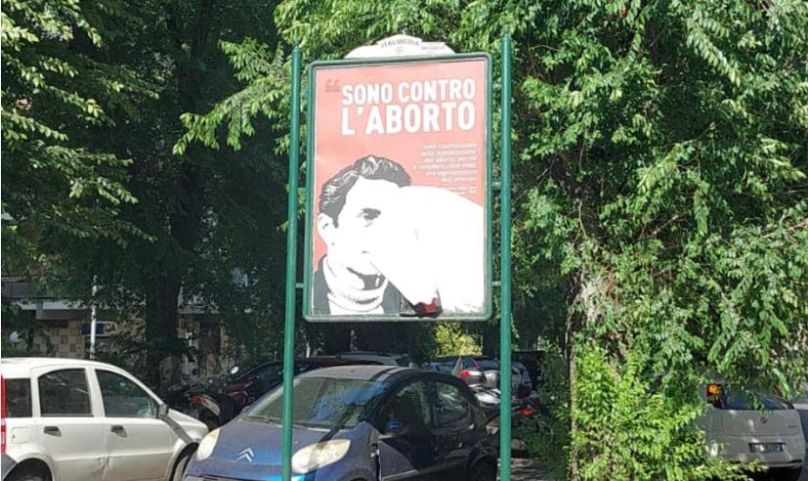
The vandalised anti-abortion posterCredit: Pro-Vita e Famiglia
‘Objectors of conscience or convenience?’
Together with 22 other EU member states, Italy gives its doctors the right to abstain from performing abortions, which are legally available to all pregnant women up to 90 days from conception following an obligatory one-week waiting period.
The right to conscientious objection is enshrined in Article 9 of Law #194, which states that “health and assistant personnel are not required to take part in […] interventions for the termination of pregnancy when conscientious objections are raised”.
But according to some pro-abortion campaigners, frequent misapplication of the provision has created a challenging situation where many women are essentially barred from accessing the services they need to obtain an abortion.
As of 2020, 64.6% of gynaecologists in Italy are conscientious objectors, a figure which soars to over 90% in parts of the south. While the nationwide percentage has decreased slightly since 2019, it has broadly grown over the years — in 2005, for instance, it stood at 58.7%.
In relatively rural southern Italian regions like Molise, this can result in there being fewer than a handful of doctors willing to carry out the operation.
For Giovanna Scassellati, a gynaecologist at Rome’s San Camillo hospital, the situation is of particular concern. Living in a city dominated by Catholic hospitals that do not provide abortion services, Scassellati works in one of the few secular facilities that perform approximately 2,000 procedures every year.
“The number of conscientious objectors has increased since the 1980s,” Scassellati told Euronews. “It can be hard to find a doctor who wants to carry out the procedure, [especially] in summer months.”
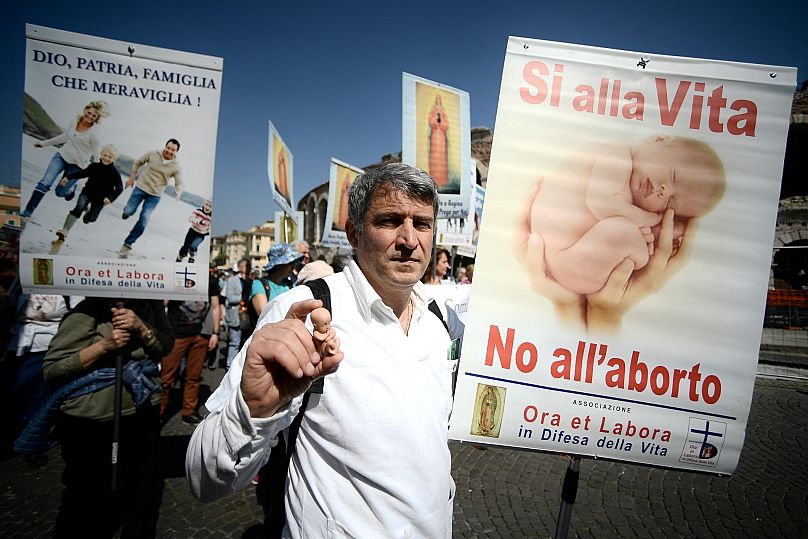
An anti-abortion activist displays a placard reading "Yes to Life, no to abortion" during a "March for Family" in VeronaCredit: AFP
Anti-abortion activists defend the right of all medical staff to object to any kind of abortion care — including pharmacists, who may even refuse to provide women with emergency contraceptives like the morning-after pill.
As Jacopo Coghe, spokesperson of the Pro-Vita e Famiglia or Pro-Life and Family association, told Euronews, “the objection of conscience in Law #194 […] speaks of ‘medical staff and assistants’ and certainly includes pharmacists too”.
But such arguments are contested by pro-abortion campaigners, who point out that Article 9 only exonerates staff who are “directly involved in the termination of a pregnancy” and not those assisting “before and after the event”.
“Here in Rome, I would prescribe women the morning-after pill,” Scassellati recounted, “and they would often come back to me with their hairs standing on end after the local pharmacy rejected their request.”
“One time we even had to get law enforcement involved. Women need to learn to fight for themselves and their rights,” she added.
While the permeation of Catholic doctrine — which explicitly condemns the voluntary termination of pregnancy — among medical staff has been deemed responsible for such a high rate of conscientious objectors in Italy, Scassellati takes a more cynical view shared by a significant proportion of Italian women.
“Many of these ‘objectors of conscience’ should be called ‘objectors of convenience’ instead,” she said. “As a non-objecting doctor, I have felt judged. People are afraid not to be objectors as they worry it could affect their careers.”
Indeed, objections on the grounds of conscience have not stopped gynaecologists from carrying out abortions — just under the rug.
In 2008, an investigation found that the island of Ischia off the coast of Naples was more than just a famed holiday resort. The picturesque isle became a destination for clandestine abortions, despite all doctors there being conscientious objectors on paper.
Allowing adoption of embryos 'would attack Italy’s abortion rights’
Abortion is legal in Italy — so why are women being refused?
Scassellati’s sentiments are echoed by Mirella Parachini, the former medical director of gynaecology at Rome’s Filippo Neri Hospital and previously president of the International Federation of Professional Abortion and Contraception Associates (FIAPAC).
For Parachini, the supposed increase in conscientious objectors is a red herring — or “a narrative peddled by journalists” — and the crux of the matter lies in systemic inadequacies in the country.
“I can state for a fact that I know many so-called ‘conscientious objectors’ who refer pregnant women to me,” she told Euronews.
“There a very few ‘real’ objectors. If you believe abortion is murder, would you send a pregnant woman to a hitman?”
“The fact is that Law 194 doesn’t get uniformly applied,” she said. “The problem at hand is structural.”
‘Finding a non-objecting gynaecologist is kind of a treasure hunt’
Conscientious objections may be protected by Italian law, but so is the obligation of every hospital facility to provide women with options to obtain an abortion. However, this is not unanimously respected by hospitals throughout the country.
A study from the Luca Coscioni Association, which fights for the right to euthanasia and reproductive healthcare, found that 31 medical facilities in Italy do not have a single non-objecting doctor.
This is part of the problem gynaecologists like Scassellati and Mirichella flag, as many women find themselves unable to access the options they need.
The Council of Europe denounced Italian practices in 2016, deeming there to be a systematic violation of women’s rights to reproductive healthcare.
Chiara Lalli, a journalist who has been researching abortion rights in Italy, said that accessing accurate information about abortion, especially when trying to find out if a certain facility provides the procedure, is still a challenge for many women.
“The problem is, we only have aggregated numbers, like averages by region,” Lalli told Euronews. “If you’re a woman who wants to abort, regional averages are of little use. Abortions happen in hospitals, not in regions.”
“Obtaining an abortion often turns into a kind of treasure hunt. It ends up boiling down to whether you know a gynaecologist, or not. And if you don’t, you end up going abroad.”
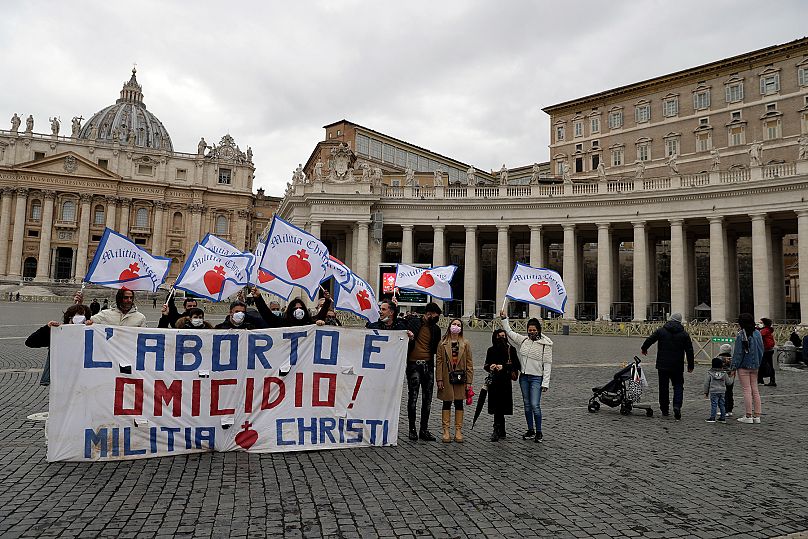
Members of Militia Christi group hold a banner reading in Italian "abortion is homicide", in St. Peter's Square, at the Vatican, 7 February 2021AP Photo/Gregorio Bo
According to Europe Abortion Access, Italians, in particular, are often forced to make difficult decisions.
A 2019 study found that 4,363 Italian women had to leave their region to obtain an abortion, and hundreds have potentially had to travel abroad, with 48 going to the UK alone.
The COVID-19 pandemic and its impact on healthcare services may have made this worse. A statistical lull in the number of abortions from 2020 might mean a greater number of women are now seeking abortions through clandestine or foreign means.
“Many prenatal services are conducted by Catholic hospitals and diagnoses are late, meaning that women have to go abroad to get one,” Scassellati noted.
“And during the pandemic, nurses were focused on battling COVID”, making the already meagre options even more scarce, she pointed out.
But some campaigners are taking action to combat such structural failings. One recently opened platform, Freedom Leaks, allows women to report injustices they have encountered while trying to obtain an abortion, as well as for medical staff to blow the whistle on what they witness at their facilities.
“It just isn’t acceptable that women don’t know which hospitals to access,” Filomena Gallo, a lawyer working on the Freedom Leaks platform, told Euronews. “Women need to know they can report any disservice.”
‘A long and embarrassing process’
Mariella is a chef living in Rome with her partner. Enjoying a successful career and what she described as a happy life, she ended up seeking an abortion six years ago at the city’s San Camillo hospital after facing an unwanted pregnancy.
While she did not regret her choice, Mariella — who asked to be introduced with a pseudonym out of concerns for her safety — recounted her experience with a mixture of frustration and indignation.
“You have a one-and-a-half hour queue at 5 am,” she told Euronews, “and the 30 to 45 women there were left in the cold without being welcomed in any shape or form. You’re basically made to feel like you’re worthless.”
“After that, you are subjected to embarrassing questionnaires on your personal and family life,” she added.
“The interview with the psychologist veers into the absurd, especially in moments when you’re asked about your personal relationship with your own mother.”
Mariella is one of the roughly 60-70,000 women who choose to get an abortion in Italy every year.
And while her experience was unpleasant, she said, she is far from being the only Italian woman to encounter various social or even legal obstacles in trying to obtain the procedure.
“The one-week waiting period is nonsensical,” she added. “Many women end up falling out of the maximum timeframe for an abortion and then have to find other solutions to obtain one.”
Mariella herself concurred with the arguments put forward by pro-abortion campaigners in Italy, who see such struggles as rooted within wider, structural complexities.
“I know of stories of women who can’t access abortions [in smaller regions in Italy] who then end up having to pay €5,000 to get one privately,” she said.
‘We don’t want to go back to the Middle Ages’
In a country marked by a long-standing and deeply complex relationship toward abortion, matters could be muddied even further after recent political developments.
Snap elections were held on 25 September, following Prime Minister Mario Draghi’s resignation and the collapse of his big-tent coalition government, leading to a surprising shift in power.
Giorgia Meloni's right-wing bloc — a broad church encompassing her nationalist Brothers of Italy or Fratelli d'Italia, Matteo Salvini’s populist Lega Nord, and former PM Silvio Berlusconi’s more moderate Forza Italia — emerged triumphant with 43.8% of the vote, and is prepping itself to form a new government.
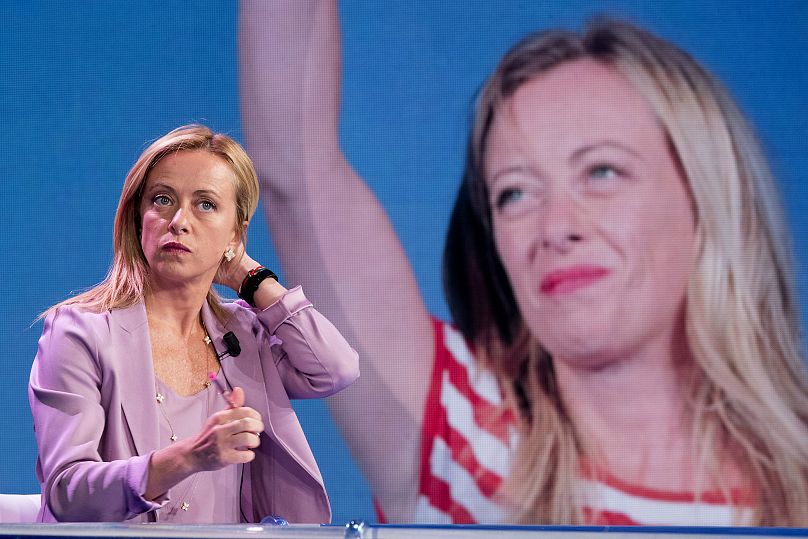
The right-wing Brothers of Italy party leader Giorgia Meloni attends the Italian state tv show "Porta a Porta" in Rome, Tuesday, Sept. 22, 2020Credit: AP
Meloni may have confirmed her respect for Law #194, but the political tradition to which she belongs is fiercely opposed to abortion.
“Yes to the culture of life! No to the promotion of death,” Meloni yelled from the podium of a pan-European far-right rally in Marbella in neighbouring Spain in July.
The Brothers of Italy manifesto for this year's elections did not explicitly decry abortion, but it did state that it wanted to advocate its "prevention".
“It’s difficult to imagine a frontal attack against abortion,” Lalli noted. “But you don’t need a frontal attack to make it inaccessible, to make it more complicated.”
In regions where right-wing politicians are in power, women’s access to different kinds of reproductive healthcare and abortion services is already limited.
In Umbria and Le Marche, which are respectively governed by Lega and Brothers of Italy, women are restricted in their ability to obtain medically-induced abortions.
To make matters even more alarming for Italian pro-abortion supporters, the revocation of Roe v Wade in the US has seemed to empower conservatives’ fight against abortion rights.
“The ripping-up of Roe shows us that no sentence or law, however long-lasting and ‘politically correct’ is untouchable, as many would have us believe,” noted anti-abortion spokesperson Coghe. “Now, other Western states, primarily Italy, can take a cue.”
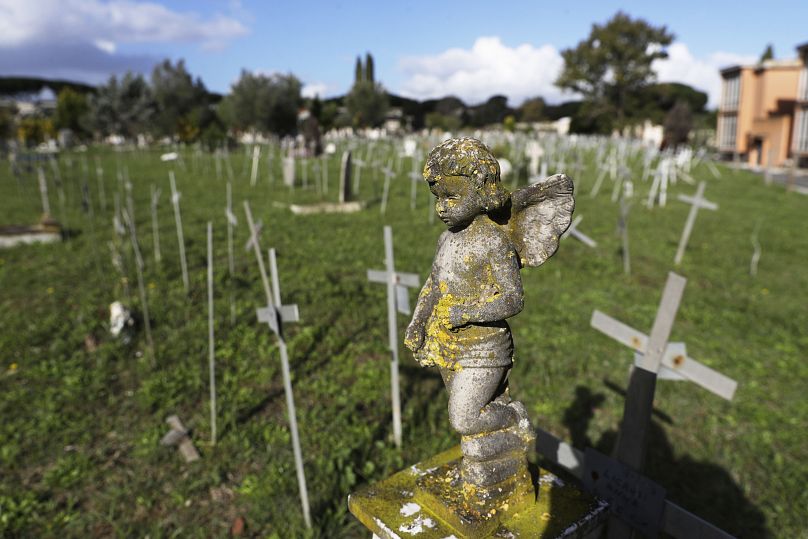
Crosses bearing tags with names are seen a graveyard of the Flaminio Cemetery in Rome in October 2020AP Photo/Gregorio Borgia
While the effects of Roe’s overturning may not necessarily impact Italian legislation, it could make the overall social climate — where women are often shamed and denigrated for choosing to terminate a pregnancy — even more fraught.
In the Italian capital itself, the discovery of a makeshift “foetal graveyard” back in 2020 prompted major outrage.
“The right to abortion is constitutionally protected, but there are other ways of denying this right,” Lalli added. “The current scenario is very complex and fragile. And it’s not just a question of the [political] right. No one in this country has had this issue to heart.”
For certain gynaecologists like Scassellati, maintaining the status quo is not enough, which is why an upcoming Meloni-led government is so concerning.
“We need to insist on a medical curriculum that teaches reproductive healthcare, and we need to reform Law #194,” she stated. “We need to bring the limit up to 14 weeks.”
“We just don’t want the right in this country,” Scassellati concluded. “We can’t go back to the Middle Ages.”
YOU MIGHT ALSO LIKE
Giorgia Meloni: Far-right leader criticised for posting video of woman's rape
'My whole world collapsed': Russians on fleeing home after Putin's speech
Italy election: In Rome's progressive neighbourhood, Meloni's victory causes anger and concern















